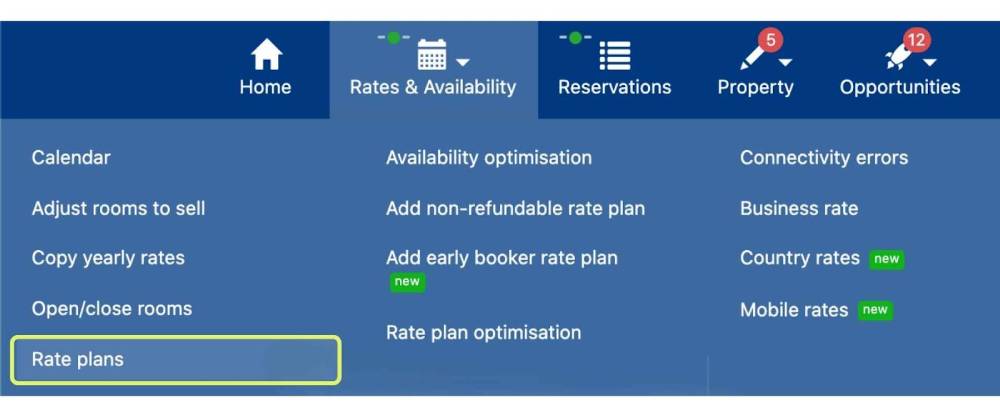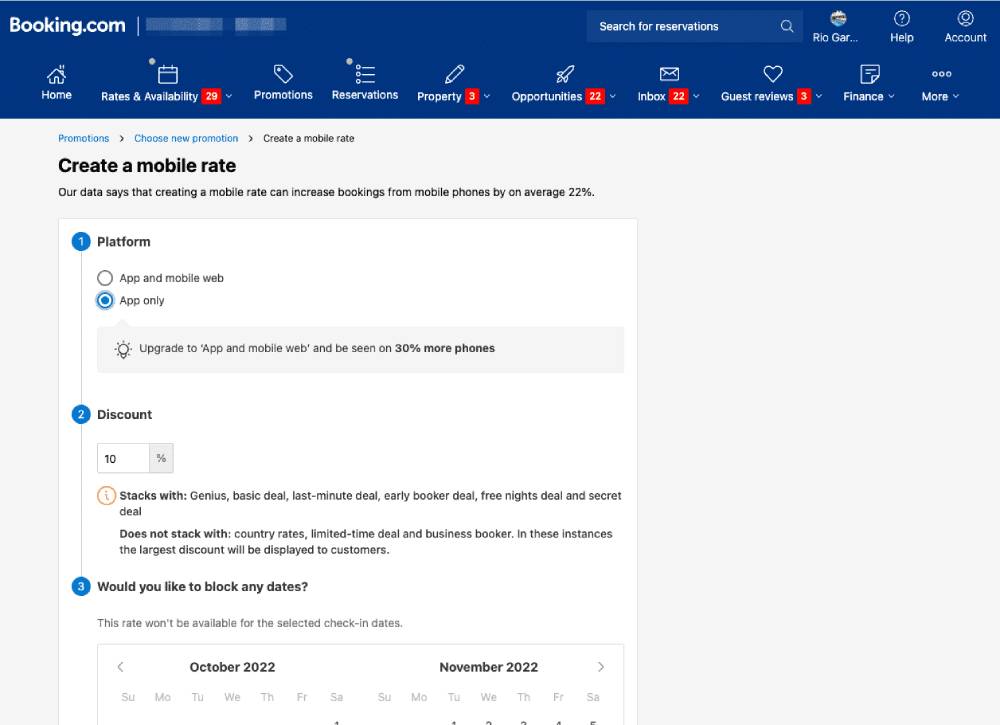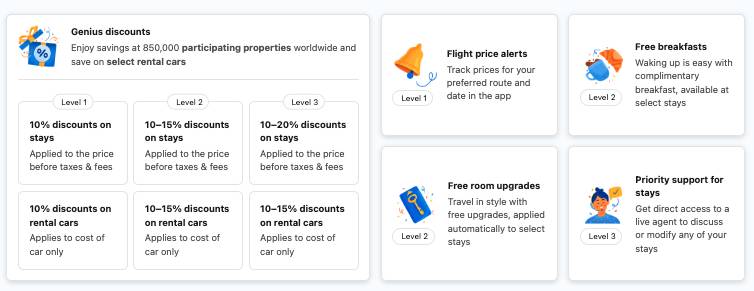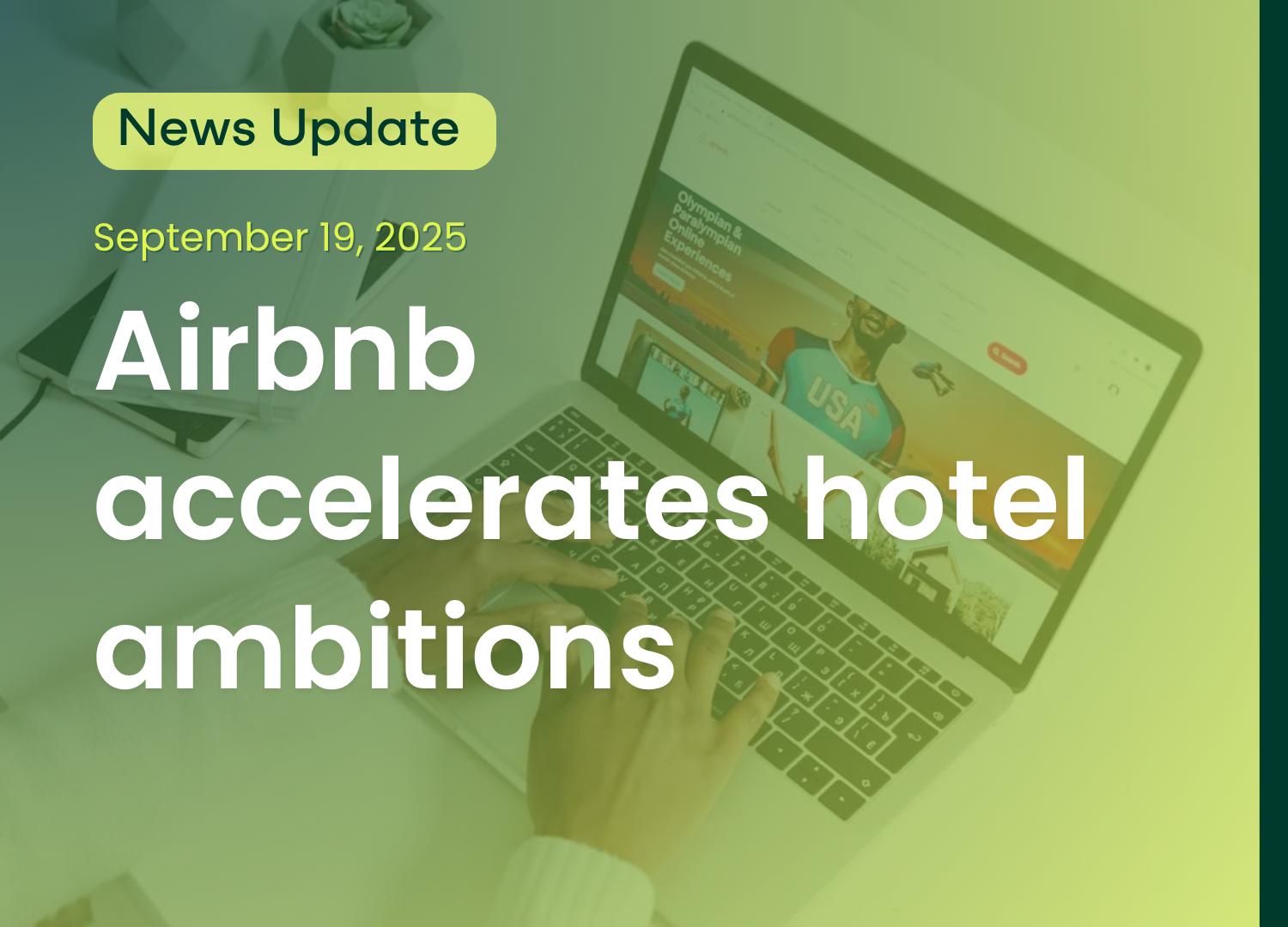Effective hotel room rate strategies for optimal pricing and occupancy
Hotels offer diverse room rates to meet guests' needs, providing a variety of choices to match their preferences and budget. This range ensures guests can find the perfect room without compromising on comfort or cost. Differentiating room rates also enables hotels to efficiently manage occupancy across seasons, maintaining a steady influx of guests and optimizing revenue potential.
In this blog, we will explore various aspects of effective hotel room pricing strategies, including defining room rates, examining different types of room rates, exploring methods for measuring rate plans, discussing pricing strategies, and highlighting best practices for hotel room types.

Table of contents
- Foundational rates: your starting point
- Best available rate (BAR)
- Standard rate (rack rate)
- Evergreen rates: your consistent performers
- Breakfast inclusive rate
- Flexible rate
- Non-refundable rate
- Advance purchase rate
- Promotional rates: driving targeted demand
- Special offers and package rates
- Loyalty and member rates
- Opaque rates
- Dynamic & group rates: advanced revenue management
- Length of stay (LOS) rate
- Last-minute rate
- Corporate rate
- Group rate
- Benefits of Diverse Hotel Room Rates
- Measure the Success of Your Rate Plans
- Dynamic pricing strategy for maximizing revenue and occupancy
- Best practices for hotel room type
- Move from dynamic pricing to revenue management
An overview of your rate plan toolkit
Before we dive deep, let's get a bird's-eye view of the tools at your disposal. This table summarizes the core rate plan categories and types that form the building blocks of a world-class pricing strategy.
Foundational rates: your starting point
Every strong pricing structure needs a solid foundation. These two rates, the Best Available Rate and the Rack Rate are the essential benchmarks from which all your other strategic prices are derived. Mastering them is the first step toward revenue optimization.
Best available rate (BAR)
The Best Available Rate, or BAR, is the most crucial, living price point in your day-to-day operations. It represents the lowest publicly available and unrestricted rate for a specific room type on a particular day. A successful best available rate pricing strategy is, by definition, dynamic. It should not be a "set it and forget it" price; instead, it must breathe with the rhythm of the market.
Its primary function is to be your lead rate, the one most visible on your website and across your primary online travel agency (OTA) channels. The core benefit of BAR is its immense flexibility. It allows you to easily capitalize on sudden spikes in demand, like a surprise concert announcement, by raising the rate, while also enabling you to stimulate occupancy during slow periods by lowering it.
However, this flexibility comes with a responsibility: vigilance. An effective BAR requires constant monitoring of key demand signals. This includes your own booking pace, competitor rate shops, local event calendars, and even broader data like flight booking trends. Without this active management, your BAR can quickly become uncompetitive, either too high to attract bookings or too low, leaving significant revenue on the table.
Standard rate (rack rate)
The rack rate is the official, non-discounted, and highest price for a room. Historically, this was the rate printed and displayed on a physical "rack" behind the front desk. While it’s rarely the rate a guest actually pays today, its strategic importance is immense. Its primary function is to act as a high psychological anchor, making every other rate you offer seem like a great value.
Think about the marketing power. A promotion offering "20% off BAR" is good, but "50% off our Rack Rate!" sounds far more compelling and urgent. The rack rate provides the benchmark that gives your discounts context and impact. It’s also often the starting point in negotiations for corporate or group contracts before agreed-upon discounts are applied. The key is to use it for reference, not as your primary selling price, as its high sticker price can deter less-savvy guests if it's the first or only rate they see.
Evergreen rates: your consistent performers
These are the diligent workhorses of your rate strategy. They offer consistent value to both your hotel and your guests throughout the year, regardless of seasonality. A well-managed hotel should have these plans as a permanent and prominent part of its rate portfolio.
Breakfast inclusive rate

This is a classic value-add, bundling the room rate with the cost of breakfast. It’s a favorite among two key segments: families, who are looking for convenience and budget predictability, and business travelers, who are often on a tight schedule and a limited daily budget.
The strategic benefit extends beyond guest appeal. By offering packages that bundle rooms with amenities like breakfast, you can often charge a premium, slightly higher than the room and breakfast priced à la carte, thus boosting your Average Daily Rate (ADR). However, this approach requires careful operational planning.
It's essential that your Property Management System (PMS) fully supports these packages to ensure seamless tracking and pricing. Additionally, you must accurately calculate the cost of goods and labor for the breakfast offering and ensure your food and beverage team is adequately staffed to handle the guaranteed volume without compromising quality.
How to add a ‘Breakfast Inclusive’ rate on Booking.com
- Go to ‘Rate Plans’ and click ‘Add new rate plan’.
- Choose to create a custom rate plan. Name it clearly (e.g., "Flexible - Breakfast Included").
- Base this new rate plan on your standard Flexible room-only rate.
- When setting the price, choose ‘Increase price by’ and enter a fixed amount per person, per night that covers your breakfast cost and desired margin.
- Under meals, ensure you select ‘Breakfast’.
Flexible rate
A flexible rate, sometimes called a "Fully Flex" rate, is your premium offering for peace of mind. It gives guests the ultimate freedom to cancel their reservation without penalty, usually up to 24 or 48 hours before arrival. In exchange for this valuable option, the guest pays a higher room rate.
This rate has become more critical than ever, appealing directly to guests whose plans may be constantly changing. While it goes along with a higher price and can significantly lift your ADR, its inherent downside is the risk of last-minute cancellations. This can disrupt your last-day forecasts and force your front desk team to rush to fill empty rooms at the last minute.
Non-refundable rate
Positioned as the counterpoint to the flexible rate, the non-refundable rate offers a modest discount for a firm commitment. For the guest who is 100% certain of their travel dates, this represents a great deal.
For the hotel, it's a powerful tool for locking in guaranteed revenue and completely eliminating the risk and cost associated with cancellations. While fantastic for your bottom line, this rate can be a deterrent for many bookers. It's crucial to always present it alongside a flexible option. Forcing a guest into a non-refundable choice may cause them to abandon the booking altogether in search of more forgiving terms elsewhere.
How to set up flexible & non-refundable rates on Booking.com

- In the extranet, go to the ‘Rates & Availability’ tab and select ‘Rate Plans’.
- Click ‘Add new rate plan’. Booking.com provides templates. Select the ‘Flexible’ template and set it up. This will be linked to your most flexible cancellation policy.
- Repeat the process, but this time select the ‘Non-Refundable’ template. This will link to your strictest cancellation policy.
- Crucially: The Non-Refundable rate should be derived from your Flexible rate. Set a discount (e.g., 10% lower) so you only ever have to manage the price of your Flexible rate, and the Non-Refundable price will adjust automatically.
Advance purchase rate
This strategy rewards guests who plan ahead. The advance purchase rate offers a significant discount to guests who book and pay for their stay well in advance. These rates are almost always fully pre-paid and non-refundable.
The primary benefit for the hotel is twofold: it builds a solid base of occupancy for future dates, making forecasting more reliable, and it provides an immediate cash flow injection. The strategic risk, however, is overselling. You must use forecasting tools to place caps on the number of rooms available at this deep discount. If you sell too much of your inventory months in advance at a low rate, and that period turns out to be high-demand, you will have missed out on substantial revenue.
How to creating an Advance Purchase (Early Booker) Deal on Booking.com
- This is a promotion, not a permanent rate plan. Go to the ‘Promotions’ tab.
- Click ‘Choose new promotion’. Select the ‘Early Booker’ deal from the portfolio.
- Set your parameters: define the discount percentage, which room types and rate plans it applies to, and how many days in advance a guest must book to receive the deal (e.g., must book at least 30 days before check-in).
Promotional rates: driving targeted demand
Promotional rates are tactical tools used to achieve specific, time-bound objectives. Whether you need to overcome a seasonal slump, capitalize on a city-wide event, or target a new demographic, these rates are your precision instruments.

Special offers and package rates
This is where you can get creative and truly differentiate your property. Package rates bundle a room with other services or local experiences, such as spa treatments, dinner reservations, golf tee times, or tickets to a local museum. A "Romantic Getaway" package, for instance, creates a unique, emotionally resonant product that is difficult for competitors to replicate apples-to-apples.
This strategy does more than just sell a room; it sells an experience, which enhances guest satisfaction and can drive significant ancillary revenue. The main challenge is logistical. It requires building strong relationships with local partners and carefully calculating margins to ensure the package is profitable for all parties involved.
Loyalty and member rates
Rewarding your past guests with an exclusive rate is one of the most cost-effective marketing strategies available. It is far cheaper to retain an existing customer than to acquire a new one. This rate fosters a loyal customer base that is generally less price-sensitive and, most importantly, more likely to book directly with you, saving you hefty OTA commissions.
This can be as simple as a "Welcome Back" discount code or part of a more formal, points-based loyalty program. The main consideration is administrative; you need a reliable Property Management System (PMS) or Customer Relationship Management (CRM) system to track your members and manage the offers effectively.
Opaque rates
Opaque rates are a special type of promotional tool used to sell distressed inventory, rooms that are likely to go unsold, without publicly slashing your prices. Guests book through an opaque channel like Hotwire or Priceline's "Name Your Own Price," where they know the general location and star rating but not the specific hotel name until after they pay.
The benefit is that you can move last-minute inventory and generate some revenue without damaging your brand's public rate integrity. The significant downside is the extremely deep discount required and the complete lack of control over who receives the rate. For most hotels, this is a strategy of last resort.
Dynamic & group rates: advanced revenue management
This category moves into more advanced territory, where rates are adjusted based not just on time, but on specific booking behaviors and the unique needs of group business.
Length of stay (LOS) rate
A Length of Stay (LOS) strategy uses a combination of discounts and restrictions to influence how long guests stay. You might offer a lower average nightly rate for stays of three nights or more to encourage longer bookings. More powerfully, you can implement restrictions like a "Minimum LOS." During a high-demand three-day weekend, setting a 3-night minimum prevents one-night stays from taking up rooms that could have been sold for the entire, more profitable weekend. This strategy is essential for maximizing revenue during compression periods, though a strict restriction can deter guests seeking shorter stays, so it must be applied with precision.
Implementing a Length of Stay (LOS) Deal on Booking.com
- Similar to the Early Booker deal, this is a promotion. Go to the ‘Promotions’ tab.
- Select either the ‘Weekly Deal’ (for stays of 7+ nights) or ‘Monthly Deal’ (for stays of 28+ nights).
- Set the discount you want to offer. This will automatically apply to any guest search that meets the minimum length of stay requirement, encouraging longer bookings.
Last-minute rate
With a significant segment of travelers, especially younger, more flexible ones, booking on the day of arrival, a last-minute rate is essential. This discount is designed to capture the attention of these spontaneous bookers and fill rooms that would otherwise perish. These offers are often best pushed through mobile-only channels to target the right demographic.
The primary danger of this strategy is predictability. If you offer a last-minute discount too frequently or consistently, you can inadvertently train your regular guests to wait for it, thus cannibalizing revenue from bookings that would have otherwise been made further in advance at a higher rate.
How to set up Last-Minute & Mobile Rates

- In the ‘Promotions’ tab, you will find options for both ‘Last-Minute Deals’ and ‘Mobile Rates’.
- Last-Minute: Target guests booking close to arrival. You set the booking window (e.g., applies to bookings made within 7 days of check-in).
- Mobile Rate: Offer an exclusive, smaller discount (e.g., 10%) that is only visible to guests searching on the Booking.com mobile app. This is highly effective for capturing the growing mobile booking segment.
Corporate rate
A corporate rate is a special, confidential rate negotiated with a company for its business travel needs. This can be the lifeblood of a hotel, providing a stable and predictable source of mid-week occupancy when leisure demand is low. These agreements often involve a discussion of the best practices for negotiating lower rates on hotel reservations.
The modern approach is to move away from a low, static rate that is fixed for the entire year. A more strategic method is a dynamic corporate rate, which offers a consistent percentage discount off your BAR. This is a win-win: the company always gets a discount, and the hotel gets to protect its margins and capitalize on high-demand periods. These rates should ideally be tied to a volume commitment, with the hotel tracking the number of room nights booked to ensure the company is holding up its end of the bargain.
How to activate Loyalty & Corporate Rates (The Genius Program)

Booking.com’s loyalty and corporate rates are managed through the Genius program.
- Go to the ‘Opportunities’ tab and find the ‘Genius Program’.
- By opting in, you automatically offer a 10% base discount to Genius Level 1 members.
- You can further enhance your offer with additional Genius perks like free breakfast or room upgrades to attract higher-value repeat travelers.
- Opting into ‘Genius Business’ specifically targets corporate travelers with the Genius discount, increasing your visibility for mid-week stays.
Group rate
Pricing for groups, like weddings, conferences, or tour operators, is a discipline unto itself. A group rate involves reserving a "room block," a specific number of rooms held for the group at a negotiated rate. This rate is held until a "cut-off date" (e.g., 30 days before arrival), after which any un-booked rooms are released back into your general inventory.
A critical component of group contracts is the attrition clause. This clause protects the hotel by stipulating that if the group fails to book a certain percentage of its promised room block (e.g., 80%), it will be liable to pay a penalty for the "lost" revenue on those unsold rooms.
How to set up group rates
Booking.com does not offer a built-in feature to create dedicated group rates. If you want to offer special pricing for groups, you’ll need to manage these rates through a revenue management system (RMS) or your property management system (PMS) that integrates with your distribution channels.
Benefits of diverse hotel room rates
Offering a variety of room rates enhances revenue and guest satisfaction. By tailoring rates to different preferences and budgets, hotels can attract a broad audience, especially during quieter periods, through strategic price adjustments.
Bundling rooms with amenities not only adds value but also boosts guest satisfaction by providing convenience and savings. Competitive and diverse pricing strategies distinguish hotels in a saturated market, adapting to both guest needs and market trends, fostering loyalty and encouraging repeat visits.
Measure the success of your rate plans
To effectively measure the success of your hotel's rate plans, it's essential to monitor the number of bookings each plan receives. By assigning a unique identifier to every rate plan in your property management system, you can accurately track their performance using two key metrics

Utilizing this tracking system enables you to identify the most and least effective rate plans, ensuring your offerings are comprehensive without overwhelming potential guests. Over time, by analyzing performance trends, you can make informed decisions on which rate plans to highlight and which to discontinue.
Hotel room rate pricing strategy for maximizing revenue and occupancy
If you really want to boost both revenue and occupancy, it’s not about sticking to just one approach, it’s about mixing and matching pricing strategies that flex with market changes, support your revenue goals, and appeal to different types of guests.
- Open pricing means you can adjust rates for different channels, room types, and dates independently, so you’re making the most of every booking opportunity.
- Added-value pricing is all about charging a little more, but giving guests something extra, like premium amenities, organic toiletries, or an upgraded in-room experience, that makes the higher rate feel worth it.
- Seasonal discount pricing helps you fill rooms in the off-season by offering lower rates, then making up the difference with extra services or relying on busier months to balance things out.
- Segment-based pricing lets you tailor offers to specific groups, like giving families a deal on longer stays or offering business travelers flexible booking perks.
And if you’re new to the market, market entry pricing, setting rates lower at first, can help you attract early guests, build a loyal following, and spread the word fast.

Best practices for hotel room pricing strategy per hotel room type
Navigating the many types of room rates and using them effectively can be tricky. Here are some key tips to help you stay competitive and maximize revenue:
- Keep package breakdowns private. Avoid showing the exact cost of individual components (like the room rate) within a package to the public, this protects your rate integrity.
- Watch the market closely. Regularly track competitor pricing and market trends so you can set your rates strategically rather than reactively.
- Use your Best Available Rate (BAR) as a guide. When adding higher-tier plans, adjust your BAR accordingly to keep your pricing structure balanced and logical.
- Prioritize mobile usability. Ensure both your website and booking process work seamlessly on mobile devices, many guests now book on the go.
- Limit visible options. Display no more than four or five of your top packages on your site at any time to prevent overwhelming guests and encourage quicker decisions.
Move from dynamic pricing to revenue management
By mastering these best practices for managing room types and rates, you’re already building a strong foundation for competitive, guest-focused pricing. But to consistently outperform the market, hotels need to go beyond simply reacting to market changes with dynamic pricing.
The next step is shifting from dynamic pricing to true revenue management. This means adding a strategic layer to your pricing, aligning rates with demand patterns, guest behavior, booking windows, and competitive positioning, so you’re not just chasing short-term gains, but building long-term profitability.
This is exactly where Otamiser makes the difference. Our solution pairs expert revenue management with our powerful visibility Booster, ensuring your property has the right price at the right time and is seen by the right guests across OTAs. By combining strategic pricing with enhanced search visibility, we help you secure more bookings, increase occupancy, and maximize your revenue potential all year round.
Learn more about our solution, and how we help hoteliers boost their revenue by on average 24%.
Otamiser helps hotels across Europe, the U.S., and Asia improve OTA rankings and revenue through data-driven pricing and local market insights.




.svg)
.svg)


.jpg)


%201.avif)

